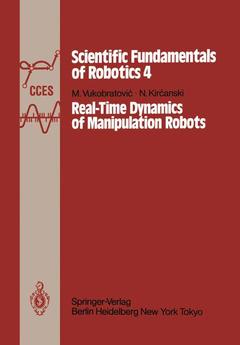Description
Real-Time Dynamics of Manipulation Robots, Softcover reprint of the original 1st ed. 1985
Scientific Fundamentals of Robotics Series
Authors: Vukobratovic M., Kircanski N.
Language: German
Subjects for Real-Time Dynamics of Manipulation Robots:
Keywords
Robotics; Robots; adaptive control; algorithms; control; model; modeling; robot; Engineering Economics
Approximative price 52.74 €
In Print (Delivery period: 15 days).
Add to cart
Publication date: 12-2011
242 p. · 17x24.4 cm · Paperback
242 p. · 17x24.4 cm · Paperback
Description
/li>Contents
/li>
This is the fourth book from the Series "Scientific Fundamentals of Ro botics". The first two volumes have established abackqround for studying the dynamics and control of robots. While the first book was exclusive ly devoted to the dynamics of active spatial mechanisms, the second treated the problems of the dynamic control of manipulation robots. In contrast to the first two books, where recursive computer-aided me thods for setting robot dynamic equations where described, this mono graph presents a new approach to the formation of robot dynamics. The goal is to achieve the real-time model computation using up-to-date mi crocomputers. The presented concept could be called a numeric-symbolic, or analytic, approach to robot modelling. It will be shown that the generation of analytical robot model may give new excellent possibili ties concerning real-time applications. It is of essential importance in synthesizing the algorithms for nonadaptive and adaptive control of manipulation robots. If should be pointed out that the high computational efficiency has been achieved by off-line computer-aided preparation of robot equations. The parameters of a specified robot must be given in advance. This, af ter each significant variation in robot structure (geometrical and dy namical parameters) ,we must repeat the off-line stage. Thus is why the numerical procedures will always have their place in studying the dy namic properties of robotic systems. This monograph is organized in 5 chapters.
1 Survey of computer-aided robot modelling methods.- 1.1. Introduction.- 1.2. Methods based on Lagrange’s equation.- 1.2.1. Uicker-Kahn’s method v.- 1.2.2. Algorithms by Mahil, Megahed and Renaud.- 1.2.3. Algorithms by Waters and Hollerbach.- 1.2.4. Vukobratovi?-Potkonjak’s recursive method.- 1.3. Methods based on Newton-Euler’s equations.- 1.3.1. Vukobratovi?-Stepanenko’s method.- 1.3.2. Huston-Kane’s method.- 1.3.3. A new recursive method.- 1.4. Methods based on Appel’s equations.- 1.5. Symbolic methods.- 1.6. Numeric-symbolic method.- 2 Computer-aided method for closed-form dynamic robot model construction.- 2.1. Introduction.- 2.2. Model based on Newton-Euler’s equations.- 2.3. Closed-form dynamic model.- 2.4. Properties of dynamic model matrices: symmetry, positive definiteness and antisymmetry.- 2.5. Closed-form linearized model.- 2.6. Closed-form sensitivity model.- Appendix 2.1.- Appendix 2.2.- 3 Computer-aided generation of numeric-symbolic robot model.- 3.1. Introduction.- 3.2. Numeric-symbolic representation of variables.- 3.3. Algebra of polynomial matrices.- 3.4. Optimization of polynomial matrices.- 3.5. Nonlinear model.- 3.6. Linearized and sensitivity model.- 3.7. Approximate models.- Appendix 3.1.- 4 Model optimization and real-time program-code generation.- 4.1. Introduction.- 4.2. Optimal computation of polynomial matrices.- 4.3. Real-time program-code generation.- Appendix 4.1.- 5 Examples.- 5.1. Introduction.- 5.2. A cylindrical robot.- 5.3. An arthropoid robot.- 5.4. An anthropomorphic robot.- 5.5. Microcomputer implementation of analytical robot models — — time-memory requirements.- Appendix 5.1.- References.
© 2024 LAVOISIER S.A.S.

